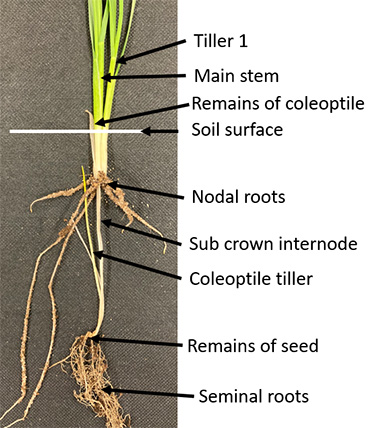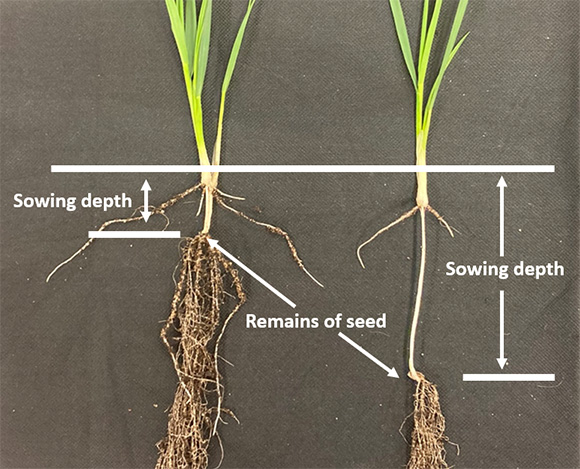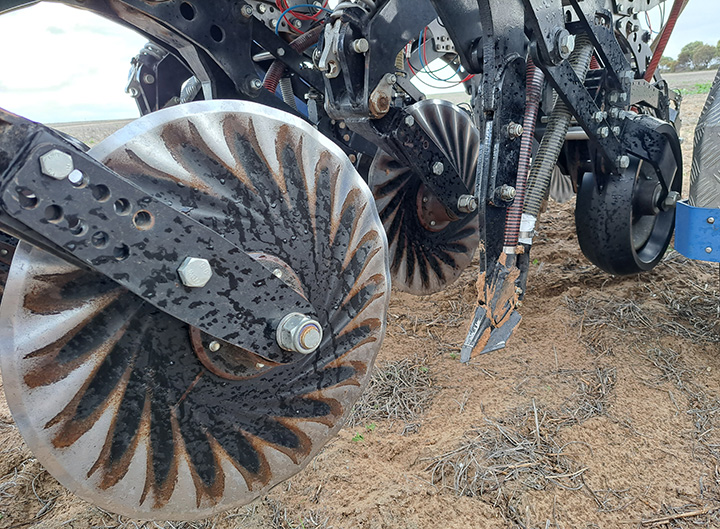Paddock Practices: wheat sowing depth and long coleoptile varieties
Paddock Practices: wheat sowing depth and long coleoptile varieties
Date: 28 Mar 2025

Key Points
- The coleoptile is the protective sheath which encloses the emerging shoot and first leaves. The longer the coleoptile is, the greater the emergence potential when deep sowing.
- Long coleoptile wheats are suitable for deep sowing up to 100 mm into subsoil moisture when surface soils are too dry
- The length of the coleoptile determines the depth of soil cover from which a seed can reliably emerge
- When deep sowing, use large seed (slotted screen size greater than 2.5 mm and no less than 2.25 mm) that exceeds 11% protein and 90% germination
- Deep sowing may require changes to your seeder setup. These changes can help to achieve efficient deep furrow loosening, optimise seed/fertiliser placement and accurately control furrow pressing
- Fertiliser should be separated from the seed to avoid fertiliser toxicity, particularly in marginal soil and coarse-textured sandy soils
- Fungicides and some pre-emergent herbicides can reduce coleoptile length. Check labels before applying treatments to seed, fertiliser or in-furrow
- A new coleoptile length classification system is being developed to ensure growers know the maximum sowing depth for each wheat variety
Overview
Changing autumn rainfall patterns are predicted to delay “seasonal break” rains throughout much of the southern and western Australian grainbelts. Seedbeds may be dry while stored water below remains just out of reach.
Long coleoptile wheats are being bred to allow deep sowing up to 100 mm into subsoil moisture when surface soils are too dry. The coleoptile is the protective sheath which encloses the emerging shoot and first leaves. The longer the coleoptile is, the greater the emergence potential when deep sowing.
The success of these varieties relies on crops establishing soon after sowing. Soil moisture and strength influence the timing and rate of germination, coleoptile growth and ultimately how many seedlings emerge.
How deep should I sow?
Sowing depth can be adjusted according to soil conditions to improve crop establishment. Sowing depth is calculated from the seed to the bottom of the press-wheel furrow and ignores any increased depth with furrow in-fill.
Seeding system design and operation can maximise seed placement depth to reach deeper soil moisture, while controlling soil cover to keep within the coleoptile length of the variety.
The optimal depth for wheat sown into ideal moist soil conditions following rainfall is widely reported at 30-40 mm below the soil surface. However, dry surface soils require sowing at depths of up to 100 mm to place the seed where soil moisture is present in the profile (figure 2).

Reported coleoptile lengths are often obtained under ideal growth conditions. Effective coleoptile length is commonly reduced by up to 15% in the field.
Aim to sow no deeper than 85% of the reported coleoptile length and increase seeding rate 10-20% if sowing at depths at or exceeding this length.
There are also other factors to consider when selected sowing depth. These include:
- Furrow in-fill. On sandy, light-textured soils, furrow in-fill can increase the realised sowing depth by another 30%. This increases the soil distance through which the seedling must emerge.
- Hard-setting and crusting soils. These soils can slow or even restrict coleoptile growth if heavy rain occurs immediately after sowing, followed by surface drying.
- High soil temperatures (above 25°C). These temperatures can reduce coleoptile length by 20-50% particularly with early April sowing on darker soils where temperatures in the top 20-40 mm reach 30°C and above.
Successful deep sowing (at depths between 80 and 100 mm) relies on three key elements:
- The seed
- The seeder
- The seeding.
Seed considerations
Which variety?
The maximum sowing depth recommended for different wheat varieties is influenced by the genetic length and strength of the coleoptile.
Deep sowing short coleoptile wheats risks delayed and reduced emergence which decreases early vigour, crop-weed competitiveness and grain yield.
A coleoptile length classification system has been developed to assist growers to identify the coleoptile length of different wheat varieties and the depths from which these can reliably emerge (table 1).
Table 1 summarises coleoptile length for different wheat varieties for small and large seed sizes germinated at 15°C. Values in brackets represent the effective coleoptile lengths corrected for sowing in the field. Varietal coleoptile lengths correspond to target sowing depths, but these ignore the potential for furrow in-fill and surface-crusting. Consider the risk of these factors separately for specific paddocks when finalising sowing depth.
Wheat Variety | Coleoptile length classification | Coleoptile length (mm) | |
|---|---|---|---|
Small seeda 2.25 – 2.50 mm | Large seedb Above 2.5 mm | ||
| Beckom | Short | 62 (54) | 65 (57) |
| Condo | Short | 55 (48) | 62 (54) |
Ironbark | Short | 62 (54) | 64 (56) |
Mowhawk | Short | 49 (43) | 51 (45) |
LRPB Raider | Short | 56 (49) | 62 (54) |
RockStar | Short | 51 (45) | 53 (46) |
Scepter | Short | 56 (49) | 61 (53) |
Shotgun | Short | 63 (55) | 65 (57) |
Vixen | Short | 52 (46) | 58 (51) |
Borlaug 100 | Medium | 74 (65) | 77 (67) |
Mace | Medium | 68 (60) | 71 (62) |
Valiant CL Plus | Medium | 64 (56) | 68 (60) |
Calibre | Mid-long | 82 (72) | 84 (74) |
Cutlass | Mid-long | 83 (73) | 85 (74) |
LRPB Dual | Mid-long | 82 (72) | 85 (74) |
Magenta | Mid-long | 79 (69) | 82 (72) |
Yitpi | Mid-long | 86 (75) | 91 (80) |
LRPB Bale | Long | 104 (91) | 106 (93) |
| Halberd | Long | 100 (88) | 107 (94) |
a 35 to 45g thousand grain weight
b Greater than 45g thousand grain weight
The importance of seed size and quality
When deep sowing, use larger seed (slotted screen greater than 2.5 mm and no smaller than 2.25mm), above 11% protein, and exceeding 90% germination.
Seed size and quality are critical determinants of success with deep sowing. Larger, plump seed produce thicker coleoptiles to aid in emergence through light, heavy-textured, and/or crusted soils.
Larger seed also has improved early vigour producing both larger leaves and more seminal (seedling) roots improving seedling recovery with deep sowing. There is also evidence that higher protein seed produces more vigorous early shoot and root development after emergence.
Seed should be whole and undamaged (no weather-damaged seed with no evidence of pre-harvest sprouting/high falling numbers) and be disease-free (no white and/or pink grains from fusarium head blight).
Where possible, use seed from the previous season and undertake germination and vigour testing to confirm seed viability. Further details can be obtained from the GRDC Retaining Seed fact sheet.
It is recommended that seeding rate be increased by 15-20% to ensure adequate emergence with deep sowing (figure 3).

Seeder setup
Seeder design
Deep sowing into stored soil moisture in many cases requires deeper furrows. Managing deeper furrows is the single most challenging aspect of deep sowing with long coleoptile varieties, imposing higher costs and slower work rates to the seeding operation.
Common issues include:
- Increased seeder draft and greater tractor power requirement
- Limitations in tyne break-out force or disc penetration capacity
- Excessive soil throw, inducing furrow ridging and uneven seed cover as well as increased crop damage risk with pre-emergent herbicides.
Tyne seeder break-out limitations or insufficient frame weight and penetration capacity with disc-seeders are made worse by dry sowing conditions in heavier soil textures, potentially also affecting seeder tracking stability.
On some double shoot seeding systems, the need for a deeper furrow can be mitigated by placing seeds via the fertiliser tube, minimising the need for extra depth of furrow tilling.
As a baseline, a seeding depth of 60-80 mm can often be achieved without any change in furrow tilling depth (eg, 80-100 mm).
On tyne-seeders, seed and fertiliser separation can be optimised side by side by using integrated seeding openers delivering both products separately at the furrow base. These winged openers are better suited to wider crop row spacing (eg, 300 mm or more) if dealing with excessive soil throw.
Growers adopting deeper sowing of long coleoptile wheat should consider:
- Adding preceding disc coulters to reduce soil throw and residue disturbance
- Upgrading to seed placement delivery options at furrow depth
- Matching press wheel tyre width and profile to control sinkage into the wider furrows, and
- Carefully adjusting down pressure to minimise over-packing risks (see section below).

What press-wheel pressure to use
Too much press-wheel down pressure under moist conditions will cause furrow compaction and higher soil strength which will reduce seedling emergence.
Too little pressure can mean unconsolidated furrow tilth which dries quickly, especially in cloddy conditions which reduces seed germination.
Deep sown, long coleoptile wheat is more sensitive to excessive press-wheel pressure than shallow sown wheat, and too much or too little press-wheel pressure can reduce emergence and early growth.
Aim for the lowest press-wheel pressure to achieve visible soil to seed consolidation within the furrow. This can often be achieved with 1 to 2 kg of down force per centimetre of press-wheel contact width. For example, a 10 cm wide press wheel should have between 10 and 20 kg of down-force when the seeder is at operating depth.
On many seeders without individual row unit depth control, adjusting the sowing depth is achieved by changing the furrow tilling depth, which may also alter press-wheel down pressure.
Seeding recommendations
Impact of pre-emergent herbicides
The use of some pre-emergent herbicides can affect seedling emergence and crop establishment when shallow sowing. Sowing deeper than 60 mm, particularly on lighter-textured, sandy soils will reduce the risk of higher soluble pre-emergent herbicide damage.
Excessive soil throw that creates furrow ridging can increase the concentration of herbicide to increase the risk of crop damage on these rows
Which seed dressings?
Growers should always check fungicide seed treatment labels to ensure seed dressings do not reduce coleoptile length or seedling vigour. For example, some seed fungicides are not recommended for sowing deeper than 50 mm so are not suitable for deep sowing strategies. Check labels carefully.
Fertiliser placement and rate
Deep sowing may require a change in the configuration of the seeder to optimise seed and fertiliser placement.
Fertiliser should be separated from seed to avoid fertiliser toxicity particularly with marginal moisture and coarse-textured sandy soils.
With deep-banding double shoot systems, where seeds may be delivered via the deep banding fertiliser tubes, the fertiliser can only be delivered above the seed. This reverse configuration may slow seedling access to fertiliser nutrients resulting in a vigour lag particularly under marginal soil moisture conditions.
Side-by-side double shoot seeding openers are now available to provide lateral separation of seed and fertiliser at the bottom of the furrow.
An alternative to a double shoot system is a single shoot system where both seed and fertiliser are delivered via the same tube without any separation. Single shoot options increase the risk of fertiliser toxicity, reducing both seedling numbers and vigour of emerged wheat seedlings. In soil types prone to fertiliser toxicity (eg. coarse-textured sandy soils) fertiliser should be separated from seed.
The likelihood of toxicity varies according to seed size, fertiliser product, fertiliser rate, soil texture and soil water content at sowing. Higher seedbed utilisation via narrower row spacing and/or wider lateral seed spread reduces the risk of fertiliser toxicity.
Further information on fertiliser toxicity can be found at in the GRDC Fertiliser Toxicity Fact Sheet.
Soil movement
Uncontrolled furrow in-fill can be caused by excessive soil throw reaching adjacent rows, furrow sidewall collapse over time or soil wash from rain and/or windblow.
Some experiments have measured an additional depth of soil of up to 50 mm increasing target sowing depths from 100 to 150 mm.
Monitoring of sowing depth is particularly important with shorter coleoptile wheats where there is reliance on continued growth of leaves for seedling emergence.
Slowing planting speed is necessary to avoid furrow-ridging from excessive soil throw which may affect up to 50% of tyne-seeder seed rows. Other considerations include soil type and residue cover, and likelihood of weather events impacting soil movement after sowing.
This paddock practices article was produced by the Grains Research and Development Corporation (GRDC) with input from CSIRO as part of the project Integrating long coleoptile wheat into Australian farming systems.
Useful Resources
GRDC podcast: Long coleoptile wheat – deep sowing seeder setup (Feb 2025)
GRDC podcast: Long coleoptile wheat – disease interaction and deep sowing (Oct 2024)
GRDC video: Long coleoptile wheat – approach and results from the first season (Aug 2024)
GRDC podcast: Long coleoptile wheat – going to great depths to avoid rhizoctonia (Jul 2024)
GRDC podcast: Sowing conventional wheat deep (Jul 2024)
GRDC podcast: Why the long coleoptile? (Jun 2024)
GRDC video: Long coleoptile wheat: national trial explores ‘game changing’ wheat varieties (May 2024)
GRDC update paper: Long coleoptile wheats – for deep seeding and optimising sowing window options (Mar 2024)
GRDC fact sheet: Retaining seed (Dec 2021)
GRDC fact sheet: Fertiliser toxicity (2011)
More Information
Dr Greg Rebetzke
CSIRO Agriculture and Food
02 6246 5153
Greg.Rebetzke@csiro.au
GRDC Project Code: CSP2212-007RTX,
